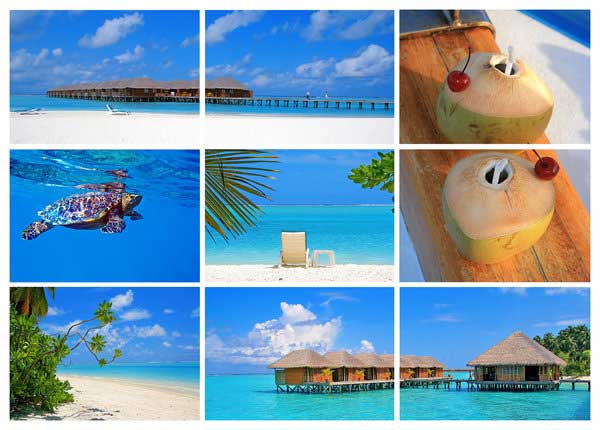The Maldives is a place that truly dazzles when you set foot there. This archipelago in the middle of the Indian Ocean comprises 1192 islands with some of the clearest waters on Earth. But how did these paradise islands come into existence and what is their future in the face of climate change?

The Origins of the Maldives Islands
According to scientific predictions, the islands of the Maldives trace back around 60 million years ago. During this era, massive volcanic eruptions occurred deep in the ocean, pushing debris towards the surface. This debris combined with the skeletal remains of dead corals in the sea, giving rise to the 1192 islands that today make up the Maldives.
Witnessing this hidden paradise nestled between the Indian Ocean and the Arabian Sea is truly a miraculous occurrence. However, due to climate change, scientists speculate that this country could be completely submerged within the next 100 years. This saddening scenario is highly likely because the Maldives has some of the lowest islands in the world, with some just 4 meters above sea level.
The Threat of Rising Sea Levels
The melting of polar ice over the years may elevate sea levels enough to submerge the Maldives. We currently have the chance to see these beautiful islets, but future generations might lose the privilege. Facing this potential global disaster, Australia took action in 2005 and announced asylum provisions for Maldivians. Situated south of the Maldives, Australia will take in citizens when rising seas impact their land.
The Equatorial Climate of the Maldives
Moreover, the Maldives lies along the Equator line. Temperatures never drop below the 30°Cs all year and the humid, tropical climate is always oppressive. During summer, hotel staff provide cold towels to prevent fainting from the extreme heat.
From Buddhism to Islam in the Maldives
This equatorial archipelago initially had a Buddhist history. Later, frequent visits by Arab traders increased the Arab Muslim population. These Arab Muslims fought off attacks by Portuguese and Dutch sailors before the British colonized the islands for 75 years until 1965.
After gaining independence under King Muhammad Fareed, the Maldives transitioned from a monarchy to today’s presidential republic system. The genetic mix of Arabs and Indians is visible in the dusky complexions of Maldivians. Almost all women wear black veils and both genders often have beards.
Maldives: A 100% Muslim Country
The Maldivian language mixes Indian and Arabic. Today, the Maldives relies on tourism and fishing. Along with Mauritania in Africa, it is considered a fully Muslim country. The white crescent on the flag symbolizes the Islamic identity.
Until 2008, the country remained isolated. Now they accept Muslim immigrants but rising seas deter permanent migration. Nonetheless, the Maldives has one of the lowest crime rates among Muslim countries.
Human Habitation Across the 1192 Islands
Over half a million registered individuals live in the Maldives, but the population isn’t evenly distributed. Only 281 of the 1192 islands have settlements. Some islands are too small for hotels. 195 islands serve locals while 86 are exclusive luxury hotels.
Affordable Stays to $100K Per Night Options
If you’re wealthy, you can rent whole islands with 50 staff catering to your needs. If not, finds start at $10 per night. Every beach has tropical plants and the sea transitions from bright turquoise to deeper blues.
Foreign Ownership in the Tourism Industry
Despite many hotels, most are owned by foreign chains. Tourist dollars don’t benefit locals. Stiff competition between hotels has made the Maldives a top global vacation spot thanks to impressive marketing. Resorts provide fantastic all-inclusive cuisine.
Locating the Maldives on a Map
If you glance quickly at a world map, you may miss the Maldives. But the vertical island clusters just below India and Sri Lanka represent this nation. Given tourism dominates the economy, the Maldives requires few visas.
Urban Life in the Capital Malé
The Maldives isn’t just endless beaches. Urban life exists too. The former Sultan’s governed Maldives from Malé, leaving it the modern capital. Life here abides by Islamic ways.
Expanding Through Artificial Islands
As Malé exceeded capacity, an artificial island called Hulhumalé was built nearby with better infrastructure. Accommodations and dining run higher there. Officially monthly income averages $800-$1000, substantial by South Asian standards.
Cuisine and Development in the Capital
Seafood dominates menus, with plentiful cheap fish. Despite some development, Malé feels behind modern capitals. Facing rising seas deters investments. You won’t find architectural marvels, fast internet or lively nightlife.
Experiencing Marine Life Up Close
At local markets, large tuna and sharks are sold, caught offshore in whale-rich waters. Capital beaches showcase the crystal clarity of the seas. Women can’t wear bikinis and men go shirtless only at hotel beaches.
Freedoms Found Within Hotel Confines
Follow Islamic customs in public, but hotels owned by Western companies provide more flexibility. On city buses, swipe any credit card instead of using a transit pass. In summary, governing and spatial restrictions limit freedoms, making the Maldives best for vacations over permanent stays.
